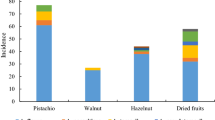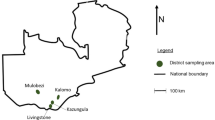Abstract
Aflatoxins are carcinogenic compounds produced by some species of Aspergillus, especially those belonging to Aspergillus section Flavi. Their occurrence in food may start in the field, in the post-harvest, or during storage due to inadequate handling and storage. Because cassava is a staple food for a high percentage of the Brazilian population, we evaluated the presence of aflatoxin-producing species in cassava tubers, cassava products (cassava flour, cassava starch, sour starch, and tapioca flour), and in soil samples collected from cassava fields. In addition, the levels of aflatoxin contamination in cassava products were quantified. A total of 101 samples were analyzed, and 45 strains of Aspergillus section Flavi were isolated. Among the identified species, Aspergillus flavus, Aspergillus arachidicola, Aspergillus novoparasiticus, and Aspergillus parasiticus were found. The majority of strains (73.3%) tested for their aflatoxin-producing ability in synthetic media was positive. Despite that, cassava and cassava products were essentially free of aflatoxins, and only one sample of cassava flour contained traces of AFB1 (0.35 μg/kg).

Similar content being viewed by others
Availability of data and material
The datasets generated during and/or analyzed during the current study are available from the corresponding author on reasonable request.
References
Adjovi YCS, Bailly S, Gnonlonfin BJG, Tadrist S, Querin A, Sanni A, Oswald IP, Puel O, Bailly JD (2014) Analysis of the contrast between natural occurrence of toxigenic Aspergilli of the Flavi section and aflatoxin B1 in cassava. Food Microbiol 38:151–159. https://doi.org/10.1016/j.fm.2013.08.005
Aghimien MO, Ikenebomeh MJ (2017) Community structure of aflatoxin producing fungi in cassava products from Nigerian geo-political zones. NISEB J 17:164–172
Alves A, Stuart G, Valduga E (2005) Alterações na qualidade de raízes de mandioca (Manihot esculenta Crantz) minimamente processadas [Changes in the quality of minimally processed cassava (Manihot esculenta Crantz)]. Ciência e Agrotecnologia 29:330–337
Alves AAC (2002) Cassava botany and physiology. Cassava Biol Prod Util 5:67–89. http://ciat-library.ciat.cgiar.org/Articulos_Ciat/cabi_08ch5.pdf
Bulatao-Jayme J, Almero EM, Castro MCA, Jardeleza MTR, Salamat LA (1982) A case-control dietary study of primary liver cancer risk from aflatoxin exposure. Int J Epidemiol 11:112–119. https://doi.org/10.1093/ije/11.2.112
Calderari TO, Iamanaka BT, Frisvad JC, Pitt JI, Sartori D, Pereira JL, Fungaro MHP, Taniwaki MH (2013) The biodiversity of Aspergillus section Flavi in brazil nuts: from rainforest to consumer. Int J Food Microbiol 160:267–272
FAO - Food and Agriculture Organization (2020) Food Supply - Crops Primary Equivalent. http://www.fao.org/faostat. Accessed 3 Feb 2020
Frisvad JC, Hubka V, Ezekiel CN, Hong SB, Nováková A, Chen AJ, Arzanlou M, Larsen TO, Sklenář F, Mahakarnchanakul W, Samson RA, Houbraken J (2019) Taxonomy of Aspergillus section Flavi and their production of aflatoxins, ochratoxins and other mycotoxins. Stud Mycol 93:01–63
Gnonlonfin GJB, Adjovi CSY, Katerere DR, Shephard GS, Sanni A, Brimer L (2012) Mycoflora and absence of aflatoxin contamination of commercialized cassava chips in Benin, West Africa. Food Control 23:333–337. https://doi.org/10.1016/j.foodcont.2011.07.026
Gnonlonfin GJB, Hell K, Fandohan P, Siame AB (2008) Mycoflora and natural occurrence of aflatoxins and fumonisin B1 in cassava and yam chips from Benin, West Africa. Int J Food Microbiol 122:140–147. https://doi.org/10.1016/j.ijfoodmicro.2007.11.047
Gomes LP, Silva LJG, Fernandes GST (2007) Identificação dos principais gêneros fúngicos nas farinhas de mandioca comercializadas nos principais mercados de Manaus [Identification of the main fungal genera in cassava flours sold in the main markets of Manaus]. Rev Igapo 01:60–64
Hong SB, Cho HS, Shin HD, Frisvad JC, Samson RA (2006) Novel Neosartorya species isolated from soil in Korea. Int J Syst Evol Microbiol 56:477–486
Iamanaka BT, Lopes AS, Martins LM, Frisvad JC, Medina A, Magan N, Sartori D, Massi FP, Fungaro MHP, Taniwaki MH (2019) Aspergillus section Flavi diversity and the role of A. novoparasiticus in aflatoxin contamination in the sugarcane production chain. Int J Food Microbiol 293:17–23
IARC - International Agency for Research on Cancer (2002) Working group on the evaluation of carcinogenic risk to humans. Some traditional herbal medicines, some mycotoxins, naphthalene and styrene. IARC Monogr Eval Carcinog Risks Hum 82:171–301
Kaaya AN, Eboku D (2010) Mould and aflatoxin contamination of dried cassava chips in Eastern Uganda: association with traditional processing and storage practices. J Biol Sci 10:718–729
Katsurayama AM, Martins LM, Iamanaka BT, Fungaro MHP, Silva JJ, Frisvad JC (2018) Occurrence of Aspergillus section Flavi and aflatoxins in Brazilian rice: from field to market. Food Microbiol 266:213–221
Kirsop BE, Snell JJS (1984) Maintenance of microrganisms. Academic Press, USA
Klich MA (2002) Identification of common Aspergillus species. Centraalbureau voor Schimmelcultures, Utrecht, Netherlands
Kumar S, Stecher G, Tamura K (2016) Mega7: molecular evolutionary genetics analysis version 7.0 for bigger datasets. Mol Biol Evol 33:1870–1874
Magnusson B, Örnemark U (2014) Eurachem guide: the fitness for purpose of analytical methods – a laboratory guide to method validation and related topics. Available at: https://www.eurachem.org/images/stories/Guides/pdf/MV_guide_2nd_ed_EN.pdf. Accessed 15 Feb 2021
Manjula K, Hell K, Fandohan P, Abass A, Bandyopadhyay R (2009) Aflatoxin and fumonisin contamination of cassava products and maize grain from markets in Tanzania and republic of the Congo. Toxin Rev 28:63–69. https://doi.org/10.1080/15569540802462214
Mesquita JS, Araújo SK, Pereira FCS (2017) Análise micológica de farinha de mandioca vendida nas feiras do produtor na cidade de Macapá-AP [Mycological analysis of cassava flour sold at the producer’s fairs in the city of Macapá-AP]. Rev Ciência e Soc 2:103–112
Muzanila YC, Brennan JG, King RD (2000) Residual cyanogens, chemical composition and aflatoxins in cassava flour from Tanzanian villages. Food Chem 70:45–49. https://doi.org/10.1016/S0308-8146(00)00062-5
Otsubo AA, Mercante FM, Martins C de S (2002) Aspectos do cultivo da mandioca em Mato Grosso do Sul [Aspects of cassava cultivation in Mato Grosso do Sul]. Available at: https://ainfo.cnptia.embrapa.br/digital/bitstream/item/38819/1/LV20021.pdf. Accessed 15 Feb 2021
Pildain MB, Frisvad JC, Vaamonde G, Cabral D, Varga J, Samson RA (2008) Two new aflatoxin producing Aspergillus species from Argentinean peanuts. Int J Syst Evol Microbiol 58:725–735
Pitt JI, Hocking AD (2009) Fungi and food spoilage. 3rd edn. Springer, New York
Ronquist F, Teslenko M, Van Der Mark P et al (2012) Efficient bayesian phylogenetic inference and model choice across a large model space. Syst Biol 61:539–542
Serviço Nacional de Aprendizagem Rural (SENAR) (2018) Agroindústria: produção de derivados da mandioca [Agroindustry: production of cassava derivatives]. SENAR: Brasília. Available at: https://www.cnabrasil.org.br/assets/arquivos/214-AGROINDUSTRIA.pdf. Accessed 12 Feb 2021
Silva JJ, Iamanaka BT, Fungaro MHP, Taniwaki MH (2019) Aflatoxins in sugarcane production chain: what could be the source? Curr Opin Food Sci 29:94–98
Stroka J, Anklam E, Jörissen U, Gilbert J (2000) Immunoaffinity column cleanup with liquid chromatography using post-column bromination for determination of aflatoxins in hazelnut paste: Interlaboratory study. J AOAC Int 83:320–340. https://doi.org/10.1093/jaoac/88.2.526
Tamura K, Nei M (1993) Estimation of the number of nucleotide substitutions in the control region of mitochondrial DNA in humans and chimpanzees. Mol Biol Evol 10:512–526
Taniwaki MH, Pitt JI (2019) Mycotoxins. Food microbiology: fundamentals and frontiers, 5th edn. ASM Press, Washington, DC, USA, pp 585–608
Thompson JD, Higgins DG, Gibson TJ (1994) CLUSTAL W: improving the sensitivity of progressive multiple sequence alignment through sequence weighting, position-specific gap penalties and weight matrix choice. Nucleic Acids Res 22:4673–4680. https://doi.org/10.1093/nar/22.22.4673
von Hertwig AM, Iamanaka BT, Neto DPA, de Rezende JB, Martins LM, Taniwaki MH, Nascimento MS (2020) Interaction of Aspergillus flavus and A. parasiticus with Salmonella spp. isolated from peanuts. Int J Food Microbiol 328:108666
Wareing PW, Westby A, Gibbs JA, Allotey LT, Halm M (2001) Consumer preferences and fungal and mycotoxin contamination of dried cassava products from Ghana. Int J Food Sci Technol 36:1–10. https://doi.org/10.1046/j.1365-2621.2001.00419.x
Funding
Fundação de Amparo à Pesquisa do Estado de São Paulo (FAPESP) (Process 2018/25552–0; 2013/05414–8; J. J. Silva grant # 2018/25597–3), Conselho Nacional de Desenvolvimento Científico e Tecnológico” (CNPq) (Process 305649/014–0), Fundação de Desenvolvimento de Pesquisa do Agronegócio (FUNDEPAG), and Coordenadoria de Aperfeiçoamento de Pessoal do Ensino Superior (CAPES).
Author information
Authors and Affiliations
Corresponding author
Ethics declarations
The experiments comply with the current Brazilian laws.
Supplementary Information
Below is the link to the electronic supplementary material.
Rights and permissions
About this article
Cite this article
Ono, L.T., Silva, J.J., Doná, S. et al. Aspergillus section Flavi and aflatoxins in Brazilian cassava (Manihot esculenta Crantz) and products. Mycotoxin Res 37, 221–228 (2021). https://doi.org/10.1007/s12550-021-00430-2
Received:
Revised:
Accepted:
Published:
Issue Date:
DOI: https://doi.org/10.1007/s12550-021-00430-2




